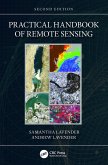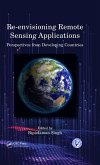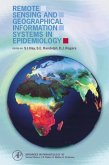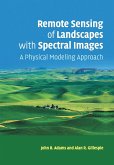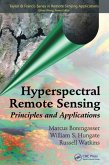Hydrologic Remote Sensing
Capacity Building for Sustainability and Resilience
Herausgeber: Hong, Yang; Khan, Sadiq; Zhang, Yu
Hydrologic Remote Sensing
Capacity Building for Sustainability and Resilience
Herausgeber: Hong, Yang; Khan, Sadiq; Zhang, Yu
- Gebundenes Buch
- Merkliste
- Auf die Merkliste
- Bewerten Bewerten
- Teilen
- Produkt teilen
- Produkterinnerung
- Produkterinnerung
Environmental remote sensing plays a critical role in observing key hydrological components such as precipitation, soil moisture, evapotranspiration and total water storage on a global scale. As water security is one of the most critical issues in the world, satellite remote sensing techniques are of particular importance for emerging regions which have inadequate in-situ gauge observations. This book reviews multiple remote sensing observations, the application of remote sensing in hydrological modeling, data assimilation and hydrological capacity building in emerging regions.
![Practical Handbook of Remote Sensing Practical Handbook of Remote Sensing]() Samantha LavenderPractical Handbook of Remote Sensing54,99 €
Samantha LavenderPractical Handbook of Remote Sensing54,99 €![Re-envisioning Remote Sensing Applications Re-envisioning Remote Sensing Applications]() Re-envisioning Remote Sensing Applications169,99 €
Re-envisioning Remote Sensing Applications169,99 €![Remote Sensing and Geographical Information Systems in Epidemiology Remote Sensing and Geographical Information Systems in Epidemiology]() Simon I. Hay / Sarah E. Randolph / David F. Rogers (Volume ed.)Remote Sensing and Geographical Information Systems in Epidemiology139,99 €
Simon I. Hay / Sarah E. Randolph / David F. Rogers (Volume ed.)Remote Sensing and Geographical Information Systems in Epidemiology139,99 €![Introduction to Satellite Remote Sensing Introduction to Satellite Remote Sensing]() William EmeryIntroduction to Satellite Remote Sensing73,99 €
William EmeryIntroduction to Satellite Remote Sensing73,99 €![Remote Sensing of Landscapes with Spectral Images Remote Sensing of Landscapes with Spectral Images]() John B. Adams (University of Washington)Remote Sensing of Landscapes with Spectral Images85,99 €
John B. Adams (University of Washington)Remote Sensing of Landscapes with Spectral Images85,99 €![Methods and Materials for Remote Sensing Methods and Materials for Remote Sensing]() Yuri AbrahamianMethods and Materials for Remote Sensing117,99 €
Yuri AbrahamianMethods and Materials for Remote Sensing117,99 €![Hyperspectral Remote Sensing Hyperspectral Remote Sensing]() Marcus Borengasser (Florida Institute of Technology, Melbourne, FloHyperspectral Remote Sensing103,99 €
Marcus Borengasser (Florida Institute of Technology, Melbourne, FloHyperspectral Remote Sensing103,99 €-
-
-
- Produktdetails
- Verlag: Taylor & Francis Inc
- Seitenzahl: 395
- Erscheinungstermin: 5. Oktober 2016
- Englisch
- Abmessung: 241mm x 163mm x 23mm
- Gewicht: 922g
- ISBN-13: 9781498726665
- ISBN-10: 1498726666
- Artikelnr.: 46164924
- Verlag: Taylor & Francis Inc
- Seitenzahl: 395
- Erscheinungstermin: 5. Oktober 2016
- Englisch
- Abmessung: 241mm x 163mm x 23mm
- Gewicht: 922g
- ISBN-13: 9781498726665
- ISBN-10: 1498726666
- Artikelnr.: 46164924
Precipitation Monitoring. Diurnal Variability of Precipitation in West
Africa Monsoon Region. ET Mapping Utilizing Remote Sensing Data. Soil
Moisture Estimation Using Active and Passive Remote Sensing Techniques.
Remote Sensing Streamflow Estimation via AMSR-E and TMI. Remote Sensing for
Surface and Ground Water Observation. Total Water Storage Observed by
GRACE. Modeling and Data Assimilation. The Coupled Routing and Excess
Storage (CREST) Distributed Hydrological Mode. AMMAS Land Surface Model
Intercomparison over West Africa. Multi-Sensor Imaging and Space-Ground
Cross-Validation for 2010 Flood along Indus River, Pakistan.
Hydroclimatology of Lake Victoria Region Using Hydrologic Model and
Satellite Remote Sensing Data. Microwave Satellite Data for Hydrologic
Modeling in an Ungauged Basin in Africa. Assimilating the Passive Microwave
Streamflow Signals for Improving the Hydrological Predictions in Okavango
River Basin, Africa. Statistical and Hydrologic Evaluation of Satellite
Precipitation Products for Mountainous Basin. Capacity Building. Real Time
Operation Hydrological Monitoring and Forecasting System for Local Decision
Makers. Satellite Remote Sensing Drought Monitoring and Predictions Over
the Globe. Capacity Building Efforts in Hydrological Modeling for Africa -
Workshops about CREST Mode. Capacity Building for Pakistan
Hydrometeorologic Hazards. Cloud-Based Cyber-Infrastructure for Disaster
Monitoring sand Mitigation Mobile Device Apps for Empowering Citizen
Scientists.
Precipitation Monitoring. Diurnal Variability of Precipitation in West
Africa Monsoon Region. ET Mapping Utilizing Remote Sensing Data. Soil
Moisture Estimation Using Active and Passive Remote Sensing Techniques.
Remote Sensing Streamflow Estimation via AMSR-E and TMI. Remote Sensing for
Surface and Ground Water Observation. Total Water Storage Observed by
GRACE. Modeling and Data Assimilation. The Coupled Routing and Excess
Storage (CREST) Distributed Hydrological Mode. AMMAS Land Surface Model
Intercomparison over West Africa. Multi-Sensor Imaging and Space-Ground
Cross-Validation for 2010 Flood along Indus River, Pakistan.
Hydroclimatology of Lake Victoria Region Using Hydrologic Model and
Satellite Remote Sensing Data. Microwave Satellite Data for Hydrologic
Modeling in an Ungauged Basin in Africa. Assimilating the Passive Microwave
Streamflow Signals for Improving the Hydrological Predictions in Okavango
River Basin, Africa. Statistical and Hydrologic Evaluation of Satellite
Precipitation Products for Mountainous Basin. Capacity Building. Real Time
Operation Hydrological Monitoring and Forecasting System for Local Decision
Makers. Satellite Remote Sensing Drought Monitoring and Predictions Over
the Globe. Capacity Building Efforts in Hydrological Modeling for Africa -
Workshops about CREST Mode. Capacity Building for Pakistan
Hydrometeorologic Hazards. Cloud-Based Cyber-Infrastructure for Disaster
Monitoring sand Mitigation Mobile Device Apps for Empowering Citizen
Scientists.


